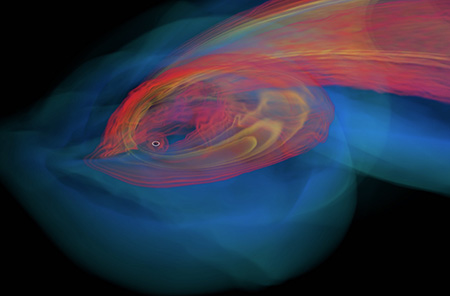UCSC: Black Hole Devouring a Star Reveals Rapid Disk Formation
Posted: Wed Aug 26, 2020 6:19 pm
New Observations of Black Hole Devouring
a Star Reveal Rapid Disk Formation
University of California, Santa Cruz | 2020 Aug 26
Prompt Accretion Disk Formation in an X-Ray Faint Tidal Disruption Event ~ Tiara Hung et al
a Star Reveal Rapid Disk Formation
University of California, Santa Cruz | 2020 Aug 26
First clear confirmation of accretion disk formation in a tidal disruption event without x-ray emissions supports theoretical predictions
When a star passes too close to a supermassive black hole, tidal forces tear it apart, producing a bright flare of radiation as material from the star falls into the black hole. Astronomers study the light from these “tidal disruption events” (TDEs) for clues to the feeding behavior of the supermassive black holes lurking at the centers of galaxies.
New TDE observations ... now provide clear evidence that debris from the star forms a rotating disk, called an accretion disk, around the black hole. Theorists have been debating whether an accretion disk can form efficiently during a tidal disruption event, and the new findings ... should help resolve that question, said first author Tiara Hung ...
“In classical theory, the TDE flare is powered by an accretion disk, producing x-rays from the inner region where hot gas spirals into the black hole,” Hung said. “But for most TDEs, we don’t see x-rays—they mostly shine in the ultraviolet and optical wavelengths—so it was suggested that, instead of a disk, we’re seeing emissions from the collision of stellar debris streams.” ...
“This is the first solid confirmation that accretion disks form in these events, even when we don’t see x-rays,” Ramirez-Ruiz said. “The region close to the black hole is obscured by an optically thick wind, so we don’t see the x-ray emissions, but we do see optical light from an extended elliptical disk.” ...
Prompt Accretion Disk Formation in an X-Ray Faint Tidal Disruption Event ~ Tiara Hung et al
- arXiv.org > astro-ph > arXiv:2003.09427 > 20 Mar 2020 (v1), 18 Aug 2020 (v2)
